DTH107 Determine Health Assessment 2: Research Report
VerifiedAdded on 2023/01/09
|15
|4121
|90
AI Summary
This document is a research report template for Assessment 2 of the DTH107 Determine Health subject in the HLT54115 Diploma of Nursing course. It provides step-by-step instructions for conducting research and creating a research report. The document covers topics such as evidence-based practice, research methods, duty of care requirements, and information gathering strategies.
Contribute Materials
Your contribution can guide someone’s learning journey. Share your
documents today.
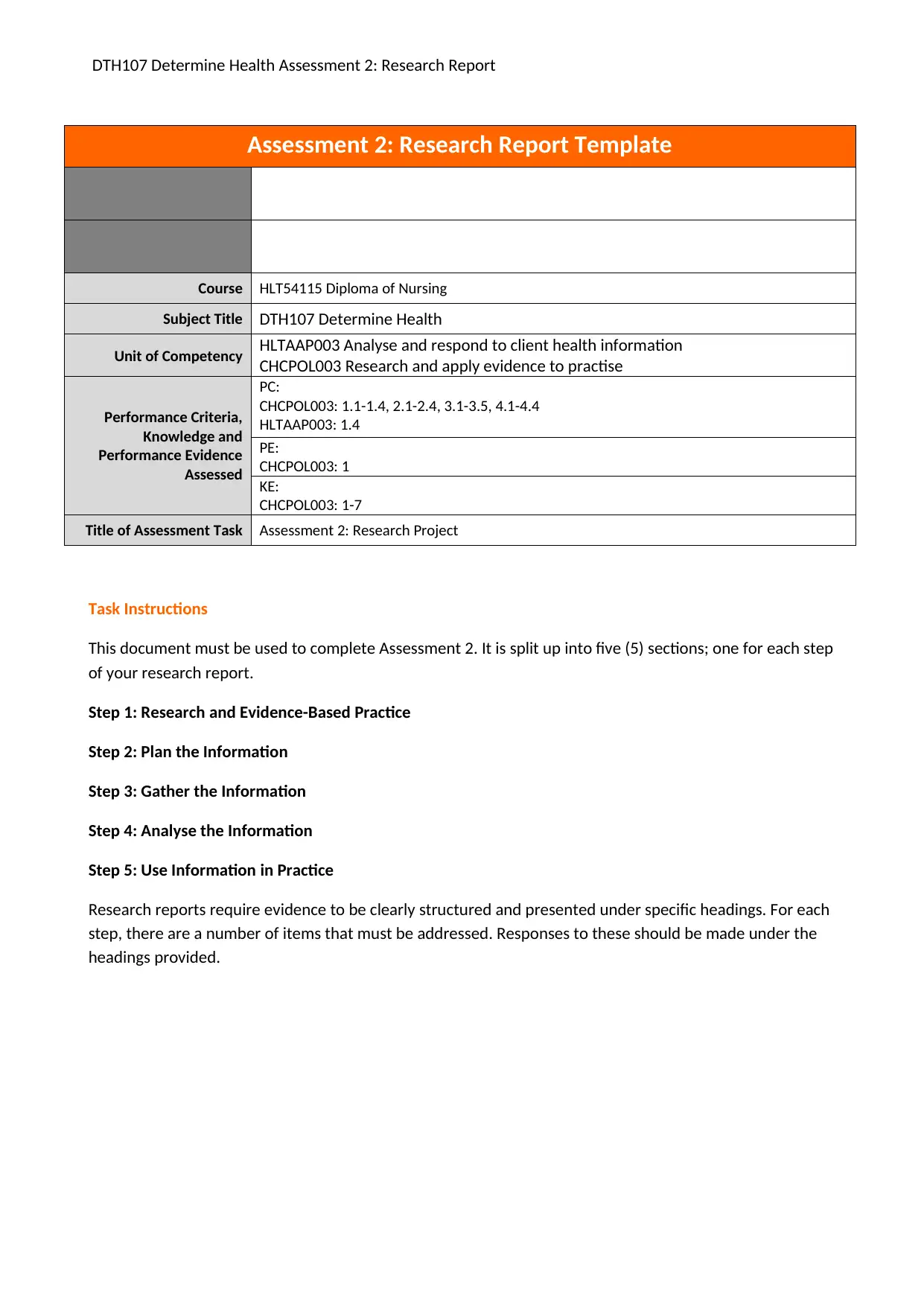
DTH107 Determine Health Assessment 2: Research Report
Assessment 2: Research Report Template
Course HLT54115 Diploma of Nursing
Subject Title DTH107 Determine Health
Unit of Competency HLTAAP003 Analyse and respond to client health information
CHCPOL003 Research and apply evidence to practise
Performance Criteria,
Knowledge and
Performance Evidence
Assessed
PC:
CHCPOL003: 1.1-1.4, 2.1-2.4, 3.1-3.5, 4.1-4.4
HLTAAP003: 1.4
PE:
CHCPOL003: 1
KE:
CHCPOL003: 1-7
Title of Assessment Task Assessment 2: Research Project
Task Instructions
This document must be used to complete Assessment 2. It is split up into five (5) sections; one for each step
of your research report.
Step 1: Research and Evidence-Based Practice
Step 2: Plan the Information
Step 3: Gather the Information
Step 4: Analyse the Information
Step 5: Use Information in Practice
Research reports require evidence to be clearly structured and presented under specific headings. For each
step, there are a number of items that must be addressed. Responses to these should be made under the
headings provided.
Assessment 2: Research Report Template
Course HLT54115 Diploma of Nursing
Subject Title DTH107 Determine Health
Unit of Competency HLTAAP003 Analyse and respond to client health information
CHCPOL003 Research and apply evidence to practise
Performance Criteria,
Knowledge and
Performance Evidence
Assessed
PC:
CHCPOL003: 1.1-1.4, 2.1-2.4, 3.1-3.5, 4.1-4.4
HLTAAP003: 1.4
PE:
CHCPOL003: 1
KE:
CHCPOL003: 1-7
Title of Assessment Task Assessment 2: Research Project
Task Instructions
This document must be used to complete Assessment 2. It is split up into five (5) sections; one for each step
of your research report.
Step 1: Research and Evidence-Based Practice
Step 2: Plan the Information
Step 3: Gather the Information
Step 4: Analyse the Information
Step 5: Use Information in Practice
Research reports require evidence to be clearly structured and presented under specific headings. For each
step, there are a number of items that must be addressed. Responses to these should be made under the
headings provided.
Secure Best Marks with AI Grader
Need help grading? Try our AI Grader for instant feedback on your assignments.
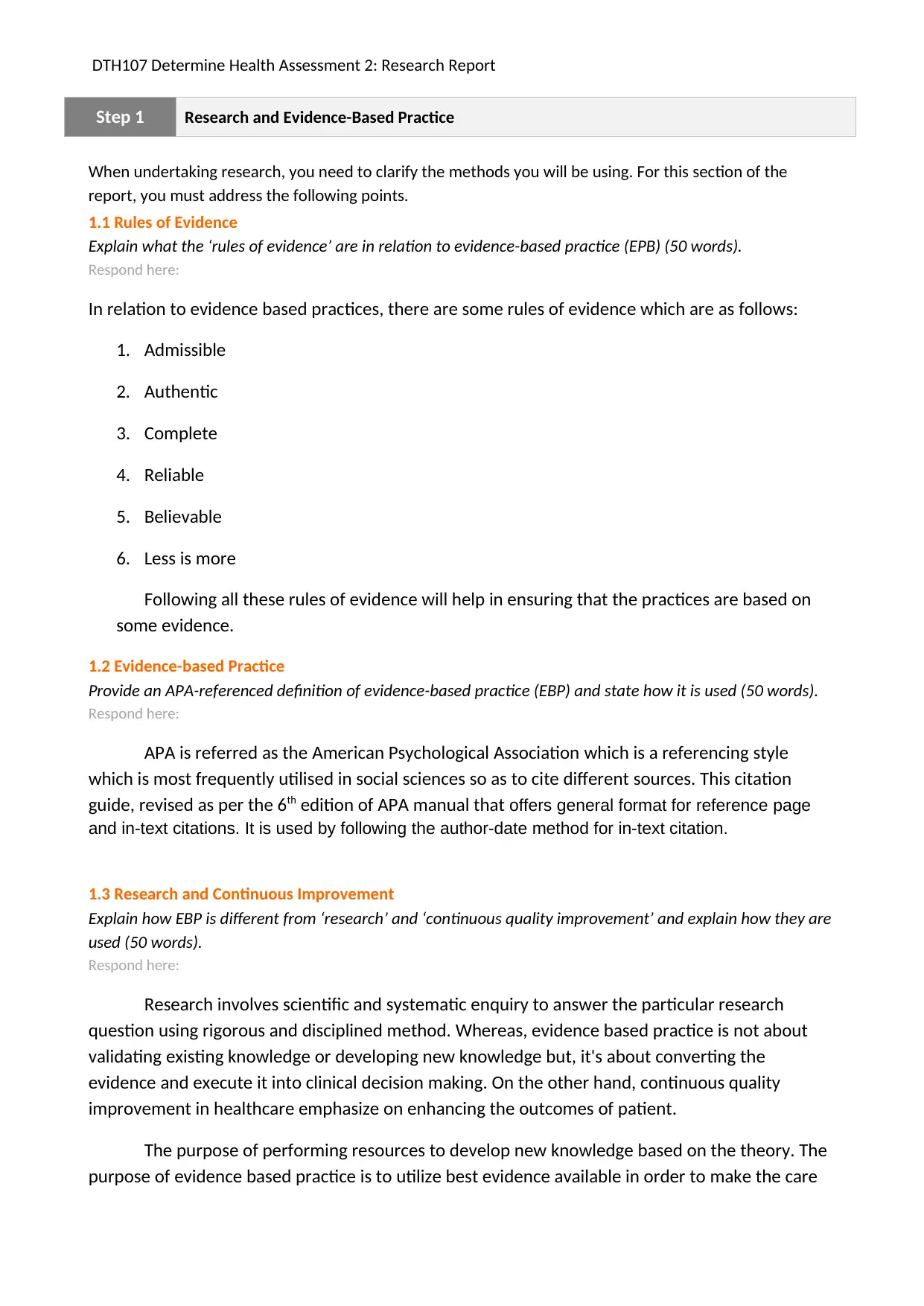
DTH107 Determine Health Assessment 2: Research Report
Step 1 Research and Evidence-Based Practice
When undertaking research, you need to clarify the methods you will be using. For this section of the
report, you must address the following points.
1.1 Rules of Evidence
Explain what the ‘rules of evidence’ are in relation to evidence-based practice (EPB) (50 words).
Respond here:
In relation to evidence based practices, there are some rules of evidence which are as follows:
1. Admissible
2. Authentic
3. Complete
4. Reliable
5. Believable
6. Less is more
Following all these rules of evidence will help in ensuring that the practices are based on
some evidence.
1.2 Evidence-based Practice
Provide an APA-referenced definition of evidence-based practice (EBP) and state how it is used (50 words).
Respond here:
APA is referred as the American Psychological Association which is a referencing style
which is most frequently utilised in social sciences so as to cite different sources. This citation
guide, revised as per the 6th edition of APA manual that offers general format for reference page
and in-text citations. It is used by following the author-date method for in-text citation.
1.3 Research and Continuous Improvement
Explain how EBP is different from ‘research’ and ‘continuous quality improvement’ and explain how they are
used (50 words).
Respond here:
Research involves scientific and systematic enquiry to answer the particular research
question using rigorous and disciplined method. Whereas, evidence based practice is not about
validating existing knowledge or developing new knowledge but, it's about converting the
evidence and execute it into clinical decision making. On the other hand, continuous quality
improvement in healthcare emphasize on enhancing the outcomes of patient.
The purpose of performing resources to develop new knowledge based on the theory. The
purpose of evidence based practice is to utilize best evidence available in order to make the care
Step 1 Research and Evidence-Based Practice
When undertaking research, you need to clarify the methods you will be using. For this section of the
report, you must address the following points.
1.1 Rules of Evidence
Explain what the ‘rules of evidence’ are in relation to evidence-based practice (EPB) (50 words).
Respond here:
In relation to evidence based practices, there are some rules of evidence which are as follows:
1. Admissible
2. Authentic
3. Complete
4. Reliable
5. Believable
6. Less is more
Following all these rules of evidence will help in ensuring that the practices are based on
some evidence.
1.2 Evidence-based Practice
Provide an APA-referenced definition of evidence-based practice (EBP) and state how it is used (50 words).
Respond here:
APA is referred as the American Psychological Association which is a referencing style
which is most frequently utilised in social sciences so as to cite different sources. This citation
guide, revised as per the 6th edition of APA manual that offers general format for reference page
and in-text citations. It is used by following the author-date method for in-text citation.
1.3 Research and Continuous Improvement
Explain how EBP is different from ‘research’ and ‘continuous quality improvement’ and explain how they are
used (50 words).
Respond here:
Research involves scientific and systematic enquiry to answer the particular research
question using rigorous and disciplined method. Whereas, evidence based practice is not about
validating existing knowledge or developing new knowledge but, it's about converting the
evidence and execute it into clinical decision making. On the other hand, continuous quality
improvement in healthcare emphasize on enhancing the outcomes of patient.
The purpose of performing resources to develop new knowledge based on the theory. The
purpose of evidence based practice is to utilize best evidence available in order to make the care
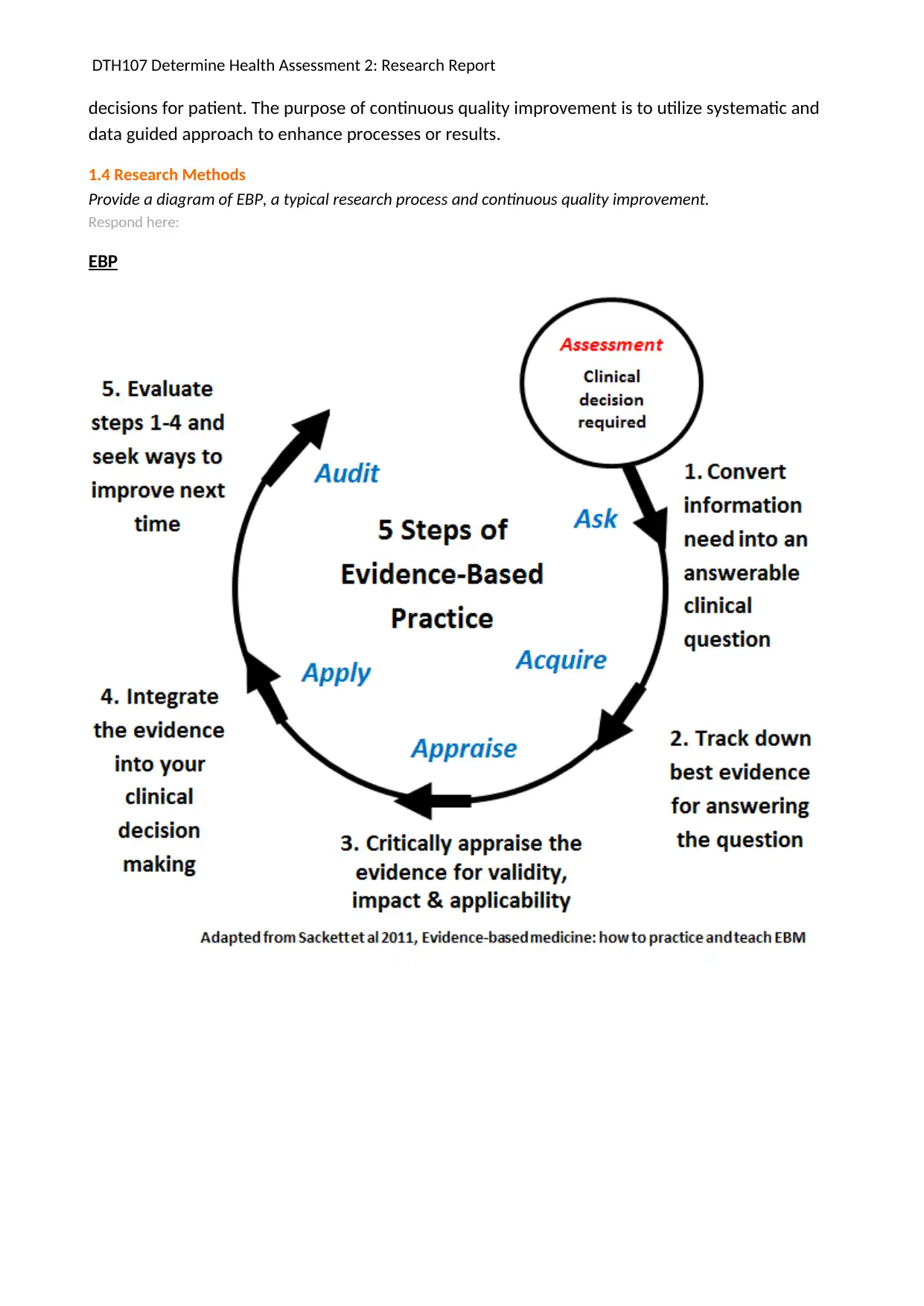
DTH107 Determine Health Assessment 2: Research Report
decisions for patient. The purpose of continuous quality improvement is to utilize systematic and
data guided approach to enhance processes or results.
1.4 Research Methods
Provide a diagram of EBP, a typical research process and continuous quality improvement.
Respond here:
EBP
decisions for patient. The purpose of continuous quality improvement is to utilize systematic and
data guided approach to enhance processes or results.
1.4 Research Methods
Provide a diagram of EBP, a typical research process and continuous quality improvement.
Respond here:
EBP
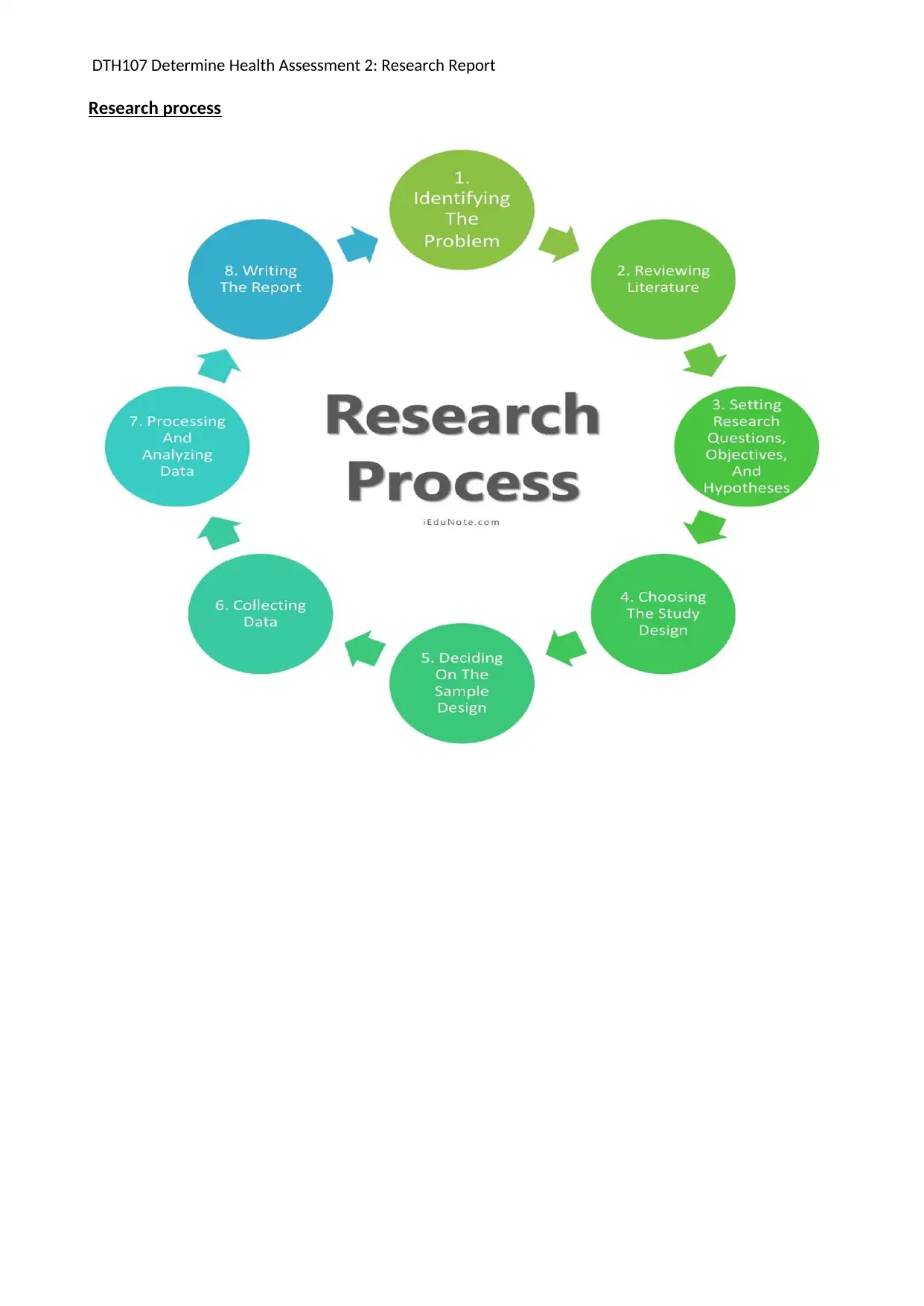
DTH107 Determine Health Assessment 2: Research Report
Research process
Research process
Secure Best Marks with AI Grader
Need help grading? Try our AI Grader for instant feedback on your assignments.
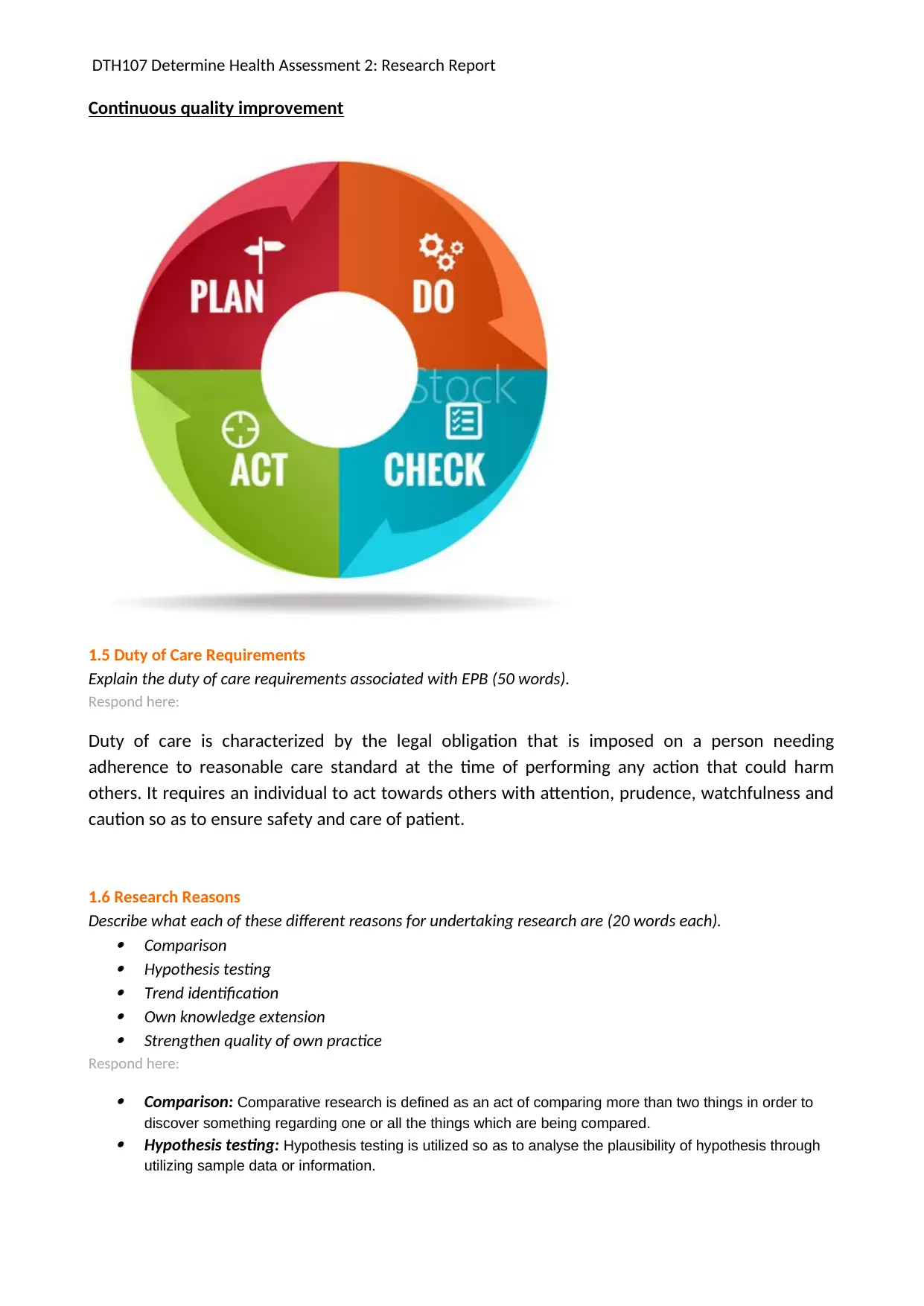
DTH107 Determine Health Assessment 2: Research Report
Continuous quality improvement
1.5 Duty of Care Requirements
Explain the duty of care requirements associated with EPB (50 words).
Respond here:
Duty of care is characterized by the legal obligation that is imposed on a person needing
adherence to reasonable care standard at the time of performing any action that could harm
others. It requires an individual to act towards others with attention, prudence, watchfulness and
caution so as to ensure safety and care of patient.
1.6 Research Reasons
Describe what each of these different reasons for undertaking research are (20 words each). Comparison Hypothesis testing Trend identification Own knowledge extension Strengthen quality of own practice
Respond here: Comparison: Comparative research is defined as an act of comparing more than two things in order to
discover something regarding one or all the things which are being compared.
Hypothesis testing: Hypothesis testing is utilized so as to analyse the plausibility of hypothesis through
utilizing sample data or information.
Continuous quality improvement
1.5 Duty of Care Requirements
Explain the duty of care requirements associated with EPB (50 words).
Respond here:
Duty of care is characterized by the legal obligation that is imposed on a person needing
adherence to reasonable care standard at the time of performing any action that could harm
others. It requires an individual to act towards others with attention, prudence, watchfulness and
caution so as to ensure safety and care of patient.
1.6 Research Reasons
Describe what each of these different reasons for undertaking research are (20 words each). Comparison Hypothesis testing Trend identification Own knowledge extension Strengthen quality of own practice
Respond here: Comparison: Comparative research is defined as an act of comparing more than two things in order to
discover something regarding one or all the things which are being compared.
Hypothesis testing: Hypothesis testing is utilized so as to analyse the plausibility of hypothesis through
utilizing sample data or information.
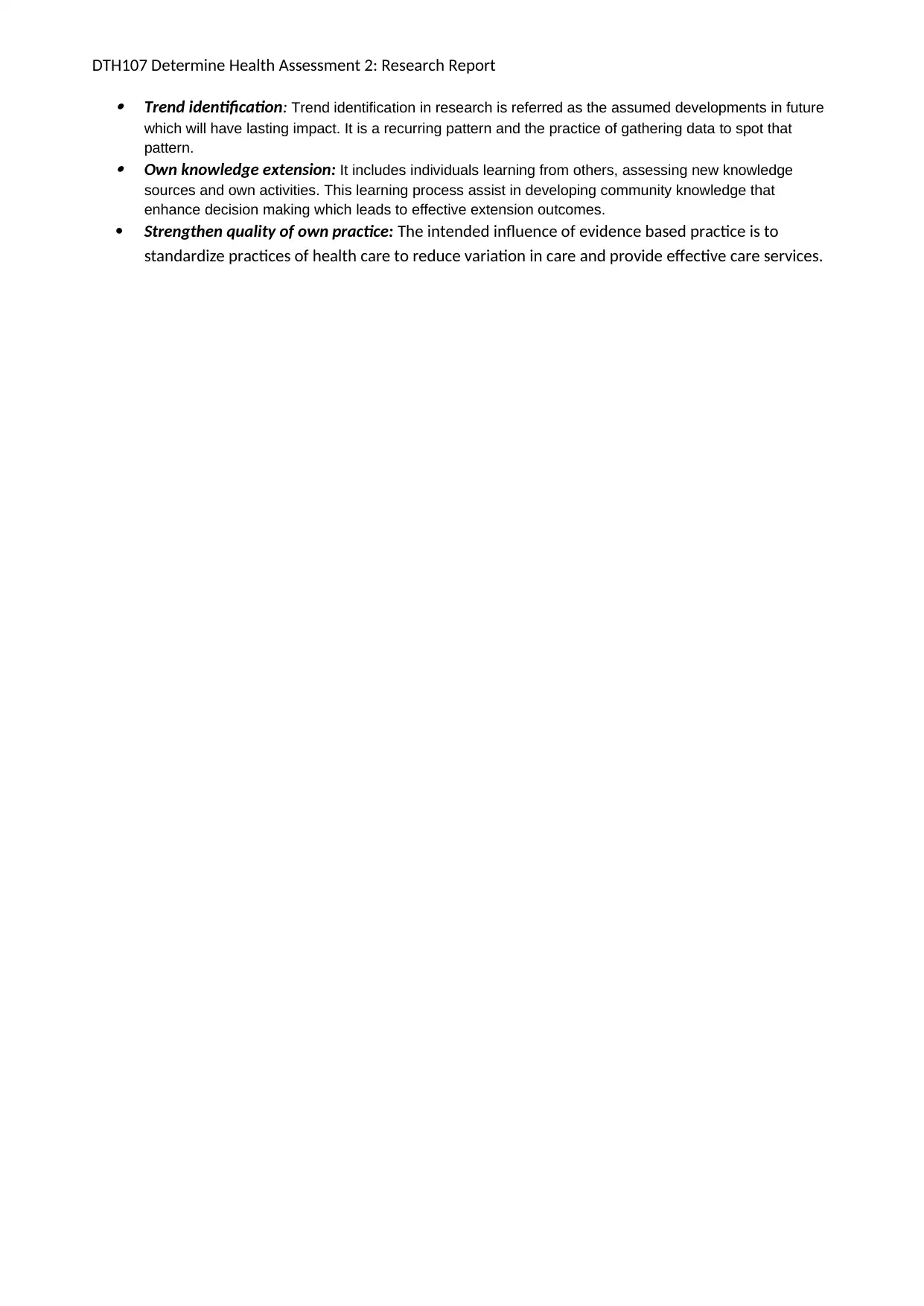
DTH107 Determine Health Assessment 2: Research Report
Trend identification: Trend identification in research is referred as the assumed developments in future
which will have lasting impact. It is a recurring pattern and the practice of gathering data to spot that
pattern.
Own knowledge extension: It includes individuals learning from others, assessing new knowledge
sources and own activities. This learning process assist in developing community knowledge that
enhance decision making which leads to effective extension outcomes.
Strengthen quality of own practice: The intended influence of evidence based practice is to
standardize practices of health care to reduce variation in care and provide effective care services.
Trend identification: Trend identification in research is referred as the assumed developments in future
which will have lasting impact. It is a recurring pattern and the practice of gathering data to spot that
pattern.
Own knowledge extension: It includes individuals learning from others, assessing new knowledge
sources and own activities. This learning process assist in developing community knowledge that
enhance decision making which leads to effective extension outcomes.
Strengthen quality of own practice: The intended influence of evidence based practice is to
standardize practices of health care to reduce variation in care and provide effective care services.
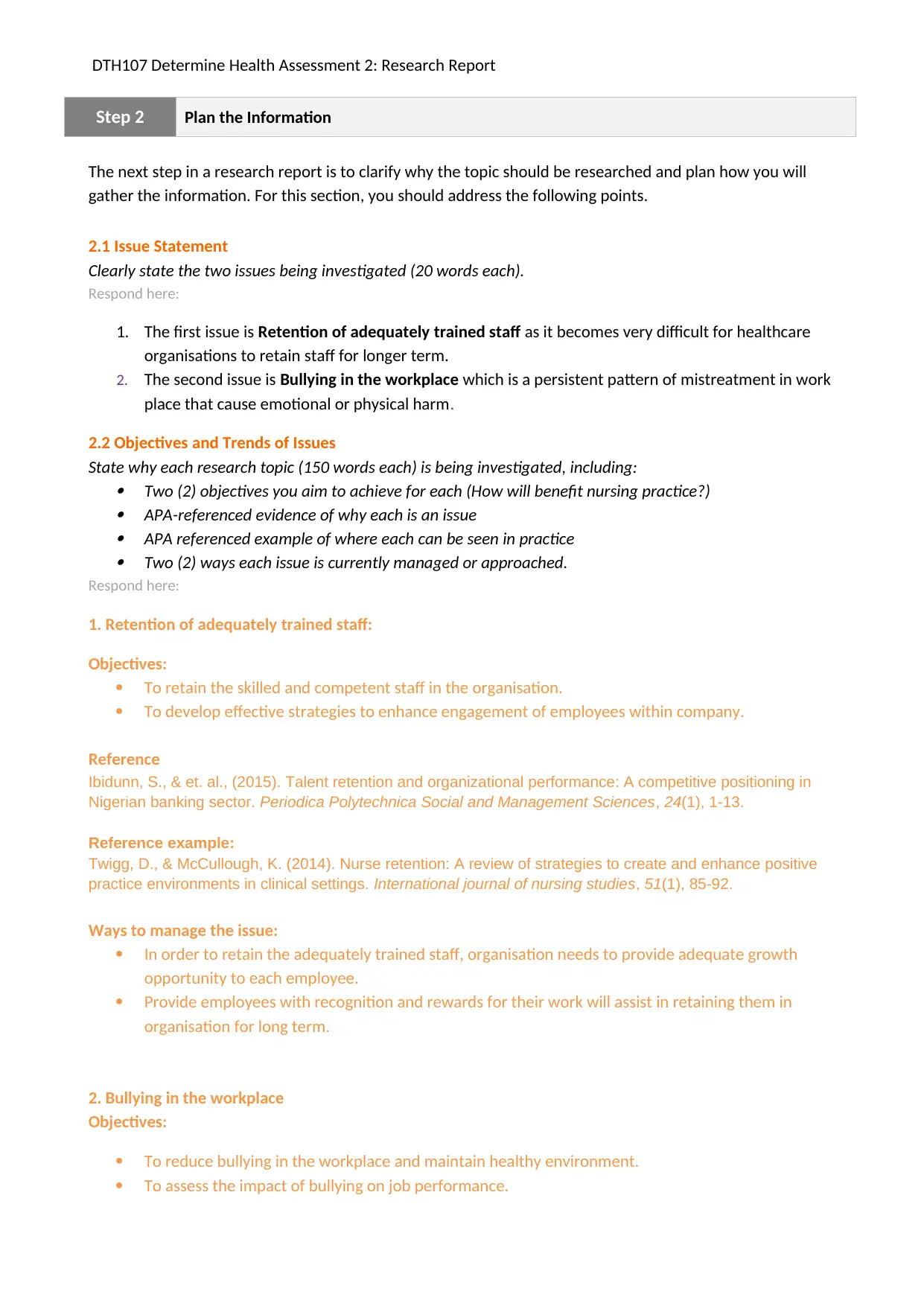
DTH107 Determine Health Assessment 2: Research Report
Step 2 Plan the Information
The next step in a research report is to clarify why the topic should be researched and plan how you will
gather the information. For this section, you should address the following points.
2.1 Issue Statement
Clearly state the two issues being investigated (20 words each).
Respond here:
1. The first issue is Retention of adequately trained staff as it becomes very difficult for healthcare
organisations to retain staff for longer term.
2. The second issue is Bullying in the workplace which is a persistent pattern of mistreatment in work
place that cause emotional or physical harm.
2.2 Objectives and Trends of Issues
State why each research topic (150 words each) is being investigated, including: Two (2) objectives you aim to achieve for each (How will benefit nursing practice?) APA-referenced evidence of why each is an issue APA referenced example of where each can be seen in practice Two (2) ways each issue is currently managed or approached.
Respond here:
1. Retention of adequately trained staff:
Objectives:
To retain the skilled and competent staff in the organisation.
To develop effective strategies to enhance engagement of employees within company.
Reference
Ibidunn, S., & et. al., (2015). Talent retention and organizational performance: A competitive positioning in
Nigerian banking sector. Periodica Polytechnica Social and Management Sciences, 24(1), 1-13.
Reference example:
Twigg, D., & McCullough, K. (2014). Nurse retention: A review of strategies to create and enhance positive
practice environments in clinical settings. International journal of nursing studies, 51(1), 85-92.
Ways to manage the issue:
In order to retain the adequately trained staff, organisation needs to provide adequate growth
opportunity to each employee.
Provide employees with recognition and rewards for their work will assist in retaining them in
organisation for long term.
2. Bullying in the workplace
Objectives:
To reduce bullying in the workplace and maintain healthy environment.
To assess the impact of bullying on job performance.
Step 2 Plan the Information
The next step in a research report is to clarify why the topic should be researched and plan how you will
gather the information. For this section, you should address the following points.
2.1 Issue Statement
Clearly state the two issues being investigated (20 words each).
Respond here:
1. The first issue is Retention of adequately trained staff as it becomes very difficult for healthcare
organisations to retain staff for longer term.
2. The second issue is Bullying in the workplace which is a persistent pattern of mistreatment in work
place that cause emotional or physical harm.
2.2 Objectives and Trends of Issues
State why each research topic (150 words each) is being investigated, including: Two (2) objectives you aim to achieve for each (How will benefit nursing practice?) APA-referenced evidence of why each is an issue APA referenced example of where each can be seen in practice Two (2) ways each issue is currently managed or approached.
Respond here:
1. Retention of adequately trained staff:
Objectives:
To retain the skilled and competent staff in the organisation.
To develop effective strategies to enhance engagement of employees within company.
Reference
Ibidunn, S., & et. al., (2015). Talent retention and organizational performance: A competitive positioning in
Nigerian banking sector. Periodica Polytechnica Social and Management Sciences, 24(1), 1-13.
Reference example:
Twigg, D., & McCullough, K. (2014). Nurse retention: A review of strategies to create and enhance positive
practice environments in clinical settings. International journal of nursing studies, 51(1), 85-92.
Ways to manage the issue:
In order to retain the adequately trained staff, organisation needs to provide adequate growth
opportunity to each employee.
Provide employees with recognition and rewards for their work will assist in retaining them in
organisation for long term.
2. Bullying in the workplace
Objectives:
To reduce bullying in the workplace and maintain healthy environment.
To assess the impact of bullying on job performance.
Paraphrase This Document
Need a fresh take? Get an instant paraphrase of this document with our AI Paraphraser
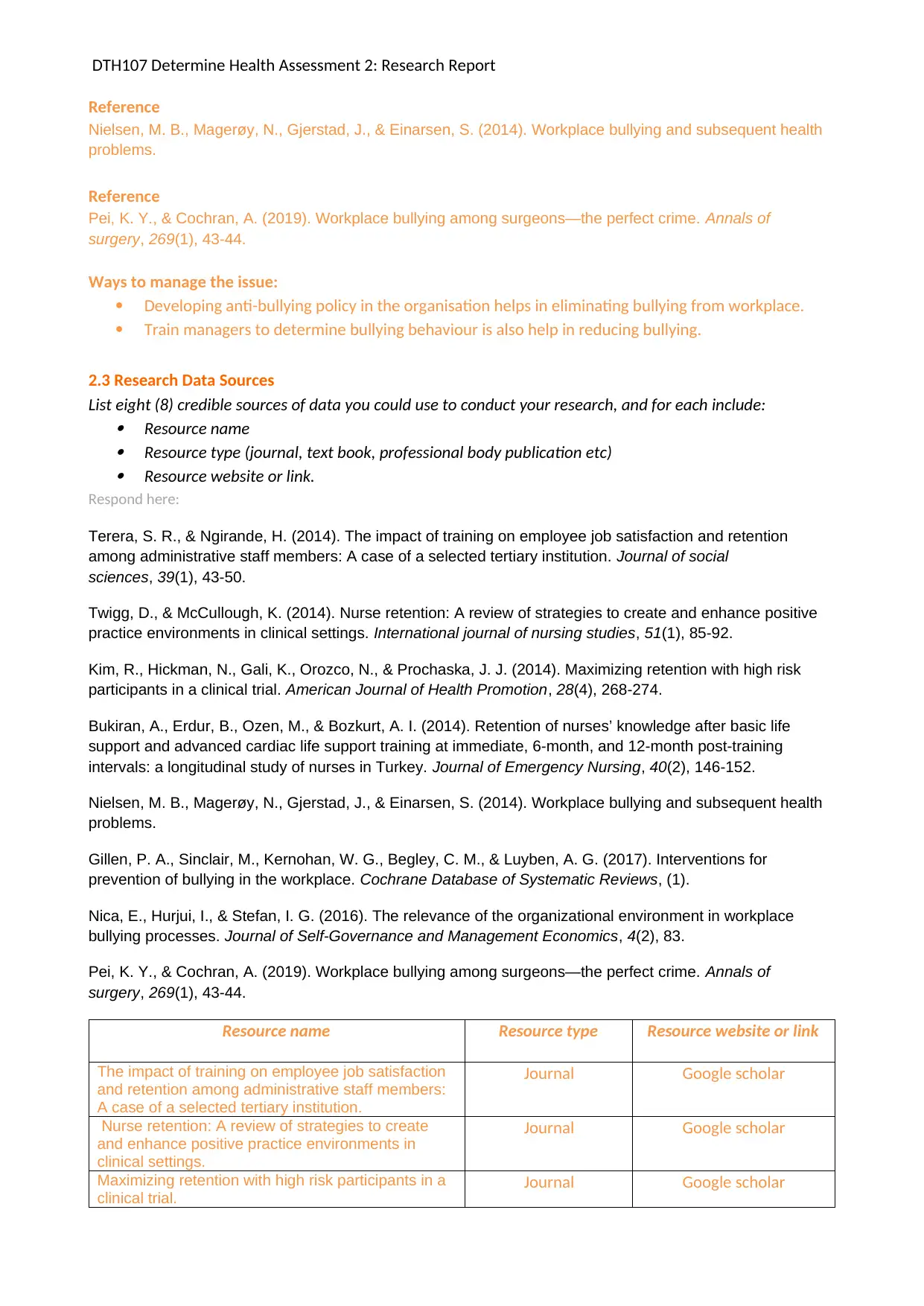
DTH107 Determine Health Assessment 2: Research Report
Reference
Nielsen, M. B., Magerøy, N., Gjerstad, J., & Einarsen, S. (2014). Workplace bullying and subsequent health
problems.
Reference
Pei, K. Y., & Cochran, A. (2019). Workplace bullying among surgeons—the perfect crime. Annals of
surgery, 269(1), 43-44.
Ways to manage the issue:
Developing anti-bullying policy in the organisation helps in eliminating bullying from workplace.
Train managers to determine bullying behaviour is also help in reducing bullying.
2.3 Research Data Sources
List eight (8) credible sources of data you could use to conduct your research, and for each include: Resource name Resource type (journal, text book, professional body publication etc) Resource website or link.
Respond here:
Terera, S. R., & Ngirande, H. (2014). The impact of training on employee job satisfaction and retention
among administrative staff members: A case of a selected tertiary institution. Journal of social
sciences, 39(1), 43-50.
Twigg, D., & McCullough, K. (2014). Nurse retention: A review of strategies to create and enhance positive
practice environments in clinical settings. International journal of nursing studies, 51(1), 85-92.
Kim, R., Hickman, N., Gali, K., Orozco, N., & Prochaska, J. J. (2014). Maximizing retention with high risk
participants in a clinical trial. American Journal of Health Promotion, 28(4), 268-274.
Bukiran, A., Erdur, B., Ozen, M., & Bozkurt, A. I. (2014). Retention of nurses’ knowledge after basic life
support and advanced cardiac life support training at immediate, 6-month, and 12-month post-training
intervals: a longitudinal study of nurses in Turkey. Journal of Emergency Nursing, 40(2), 146-152.
Nielsen, M. B., Magerøy, N., Gjerstad, J., & Einarsen, S. (2014). Workplace bullying and subsequent health
problems.
Gillen, P. A., Sinclair, M., Kernohan, W. G., Begley, C. M., & Luyben, A. G. (2017). Interventions for
prevention of bullying in the workplace. Cochrane Database of Systematic Reviews, (1).
Nica, E., Hurjui, I., & Stefan, I. G. (2016). The relevance of the organizational environment in workplace
bullying processes. Journal of Self-Governance and Management Economics, 4(2), 83.
Pei, K. Y., & Cochran, A. (2019). Workplace bullying among surgeons—the perfect crime. Annals of
surgery, 269(1), 43-44.
Resource name Resource type Resource website or link
The impact of training on employee job satisfaction
and retention among administrative staff members:
A case of a selected tertiary institution.
Journal Google scholar
Nurse retention: A review of strategies to create
and enhance positive practice environments in
clinical settings.
Journal Google scholar
Maximizing retention with high risk participants in a
clinical trial.
Journal Google scholar
Reference
Nielsen, M. B., Magerøy, N., Gjerstad, J., & Einarsen, S. (2014). Workplace bullying and subsequent health
problems.
Reference
Pei, K. Y., & Cochran, A. (2019). Workplace bullying among surgeons—the perfect crime. Annals of
surgery, 269(1), 43-44.
Ways to manage the issue:
Developing anti-bullying policy in the organisation helps in eliminating bullying from workplace.
Train managers to determine bullying behaviour is also help in reducing bullying.
2.3 Research Data Sources
List eight (8) credible sources of data you could use to conduct your research, and for each include: Resource name Resource type (journal, text book, professional body publication etc) Resource website or link.
Respond here:
Terera, S. R., & Ngirande, H. (2014). The impact of training on employee job satisfaction and retention
among administrative staff members: A case of a selected tertiary institution. Journal of social
sciences, 39(1), 43-50.
Twigg, D., & McCullough, K. (2014). Nurse retention: A review of strategies to create and enhance positive
practice environments in clinical settings. International journal of nursing studies, 51(1), 85-92.
Kim, R., Hickman, N., Gali, K., Orozco, N., & Prochaska, J. J. (2014). Maximizing retention with high risk
participants in a clinical trial. American Journal of Health Promotion, 28(4), 268-274.
Bukiran, A., Erdur, B., Ozen, M., & Bozkurt, A. I. (2014). Retention of nurses’ knowledge after basic life
support and advanced cardiac life support training at immediate, 6-month, and 12-month post-training
intervals: a longitudinal study of nurses in Turkey. Journal of Emergency Nursing, 40(2), 146-152.
Nielsen, M. B., Magerøy, N., Gjerstad, J., & Einarsen, S. (2014). Workplace bullying and subsequent health
problems.
Gillen, P. A., Sinclair, M., Kernohan, W. G., Begley, C. M., & Luyben, A. G. (2017). Interventions for
prevention of bullying in the workplace. Cochrane Database of Systematic Reviews, (1).
Nica, E., Hurjui, I., & Stefan, I. G. (2016). The relevance of the organizational environment in workplace
bullying processes. Journal of Self-Governance and Management Economics, 4(2), 83.
Pei, K. Y., & Cochran, A. (2019). Workplace bullying among surgeons—the perfect crime. Annals of
surgery, 269(1), 43-44.
Resource name Resource type Resource website or link
The impact of training on employee job satisfaction
and retention among administrative staff members:
A case of a selected tertiary institution.
Journal Google scholar
Nurse retention: A review of strategies to create
and enhance positive practice environments in
clinical settings.
Journal Google scholar
Maximizing retention with high risk participants in a
clinical trial.
Journal Google scholar
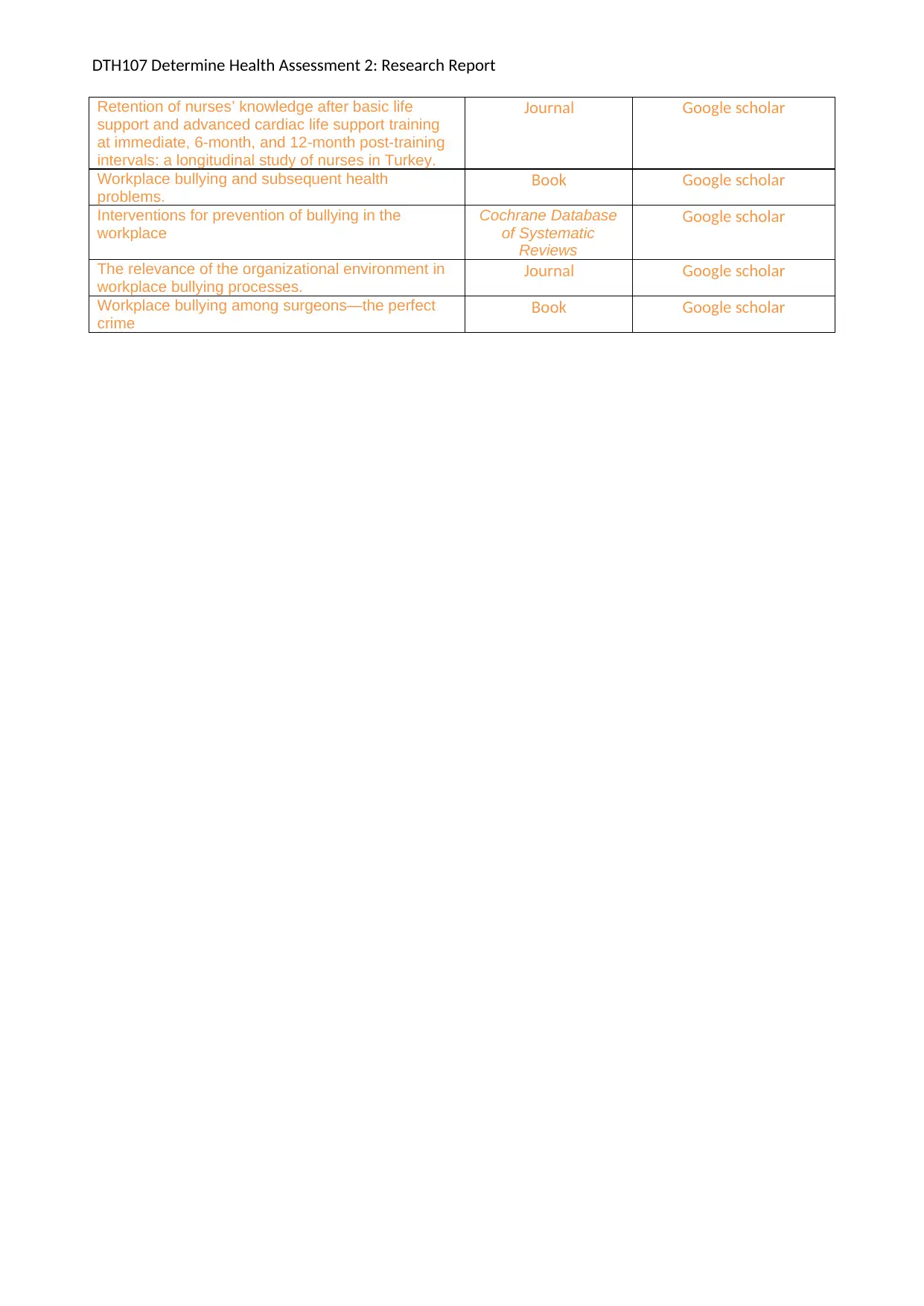
DTH107 Determine Health Assessment 2: Research Report
Retention of nurses’ knowledge after basic life
support and advanced cardiac life support training
at immediate, 6-month, and 12-month post-training
intervals: a longitudinal study of nurses in Turkey.
Journal Google scholar
Workplace bullying and subsequent health
problems.
Book Google scholar
Interventions for prevention of bullying in the
workplace
Cochrane Database
of Systematic
Reviews
Google scholar
The relevance of the organizational environment in
workplace bullying processes.
Journal Google scholar
Workplace bullying among surgeons—the perfect
crime
Book Google scholar
Retention of nurses’ knowledge after basic life
support and advanced cardiac life support training
at immediate, 6-month, and 12-month post-training
intervals: a longitudinal study of nurses in Turkey.
Journal Google scholar
Workplace bullying and subsequent health
problems.
Book Google scholar
Interventions for prevention of bullying in the
workplace
Cochrane Database
of Systematic
Reviews
Google scholar
The relevance of the organizational environment in
workplace bullying processes.
Journal Google scholar
Workplace bullying among surgeons—the perfect
crime
Book Google scholar
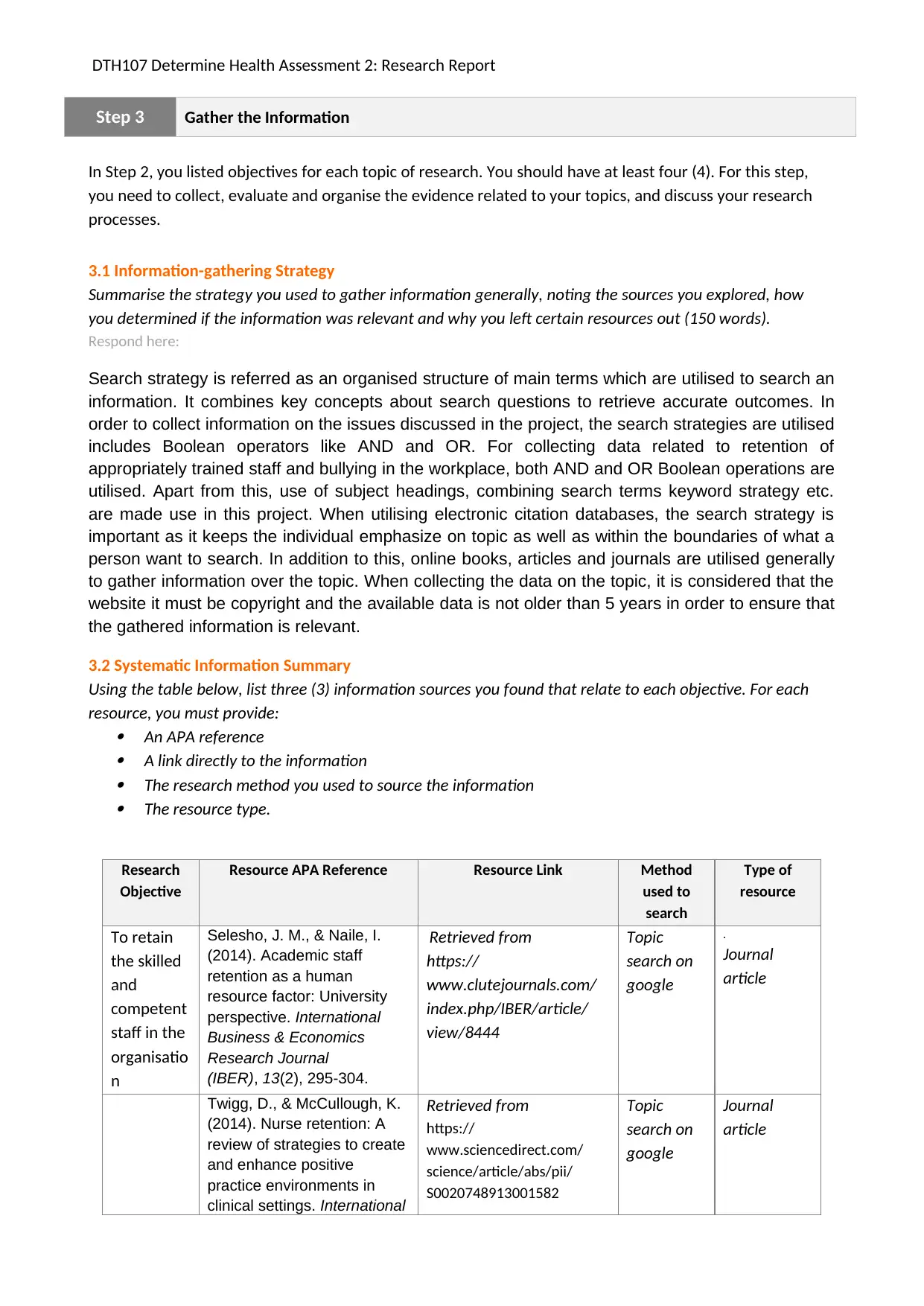
DTH107 Determine Health Assessment 2: Research Report
Step 3 Gather the Information
In Step 2, you listed objectives for each topic of research. You should have at least four (4). For this step,
you need to collect, evaluate and organise the evidence related to your topics, and discuss your research
processes.
3.1 Information-gathering Strategy
Summarise the strategy you used to gather information generally, noting the sources you explored, how
you determined if the information was relevant and why you left certain resources out (150 words).
Respond here:
Search strategy is referred as an organised structure of main terms which are utilised to search an
information. It combines key concepts about search questions to retrieve accurate outcomes. In
order to collect information on the issues discussed in the project, the search strategies are utilised
includes Boolean operators like AND and OR. For collecting data related to retention of
appropriately trained staff and bullying in the workplace, both AND and OR Boolean operations are
utilised. Apart from this, use of subject headings, combining search terms keyword strategy etc.
are made use in this project. When utilising electronic citation databases, the search strategy is
important as it keeps the individual emphasize on topic as well as within the boundaries of what a
person want to search. In addition to this, online books, articles and journals are utilised generally
to gather information over the topic. When collecting the data on the topic, it is considered that the
website it must be copyright and the available data is not older than 5 years in order to ensure that
the gathered information is relevant.
3.2 Systematic Information Summary
Using the table below, list three (3) information sources you found that relate to each objective. For each
resource, you must provide: An APA reference A link directly to the information The research method you used to source the information The resource type.
Research
Objective
Resource APA Reference Resource Link Method
used to
search
Type of
resource
To retain
the skilled
and
competent
staff in the
organisatio
n
Selesho, J. M., & Naile, I.
(2014). Academic staff
retention as a human
resource factor: University
perspective. International
Business & Economics
Research Journal
(IBER), 13(2), 295-304.
Retrieved from
https://
www.clutejournals.com/
index.php/IBER/article/
view/8444
Topic
search on
google
.
Journal
article
Twigg, D., & McCullough, K.
(2014). Nurse retention: A
review of strategies to create
and enhance positive
practice environments in
clinical settings. International
Retrieved from
https://
www.sciencedirect.com/
science/article/abs/pii/
S0020748913001582
Topic
search on
google
Journal
article
Step 3 Gather the Information
In Step 2, you listed objectives for each topic of research. You should have at least four (4). For this step,
you need to collect, evaluate and organise the evidence related to your topics, and discuss your research
processes.
3.1 Information-gathering Strategy
Summarise the strategy you used to gather information generally, noting the sources you explored, how
you determined if the information was relevant and why you left certain resources out (150 words).
Respond here:
Search strategy is referred as an organised structure of main terms which are utilised to search an
information. It combines key concepts about search questions to retrieve accurate outcomes. In
order to collect information on the issues discussed in the project, the search strategies are utilised
includes Boolean operators like AND and OR. For collecting data related to retention of
appropriately trained staff and bullying in the workplace, both AND and OR Boolean operations are
utilised. Apart from this, use of subject headings, combining search terms keyword strategy etc.
are made use in this project. When utilising electronic citation databases, the search strategy is
important as it keeps the individual emphasize on topic as well as within the boundaries of what a
person want to search. In addition to this, online books, articles and journals are utilised generally
to gather information over the topic. When collecting the data on the topic, it is considered that the
website it must be copyright and the available data is not older than 5 years in order to ensure that
the gathered information is relevant.
3.2 Systematic Information Summary
Using the table below, list three (3) information sources you found that relate to each objective. For each
resource, you must provide: An APA reference A link directly to the information The research method you used to source the information The resource type.
Research
Objective
Resource APA Reference Resource Link Method
used to
search
Type of
resource
To retain
the skilled
and
competent
staff in the
organisatio
n
Selesho, J. M., & Naile, I.
(2014). Academic staff
retention as a human
resource factor: University
perspective. International
Business & Economics
Research Journal
(IBER), 13(2), 295-304.
Retrieved from
https://
www.clutejournals.com/
index.php/IBER/article/
view/8444
Topic
search on
.
Journal
article
Twigg, D., & McCullough, K.
(2014). Nurse retention: A
review of strategies to create
and enhance positive
practice environments in
clinical settings. International
Retrieved from
https://
www.sciencedirect.com/
science/article/abs/pii/
S0020748913001582
Topic
search on
Journal
article
Secure Best Marks with AI Grader
Need help grading? Try our AI Grader for instant feedback on your assignments.
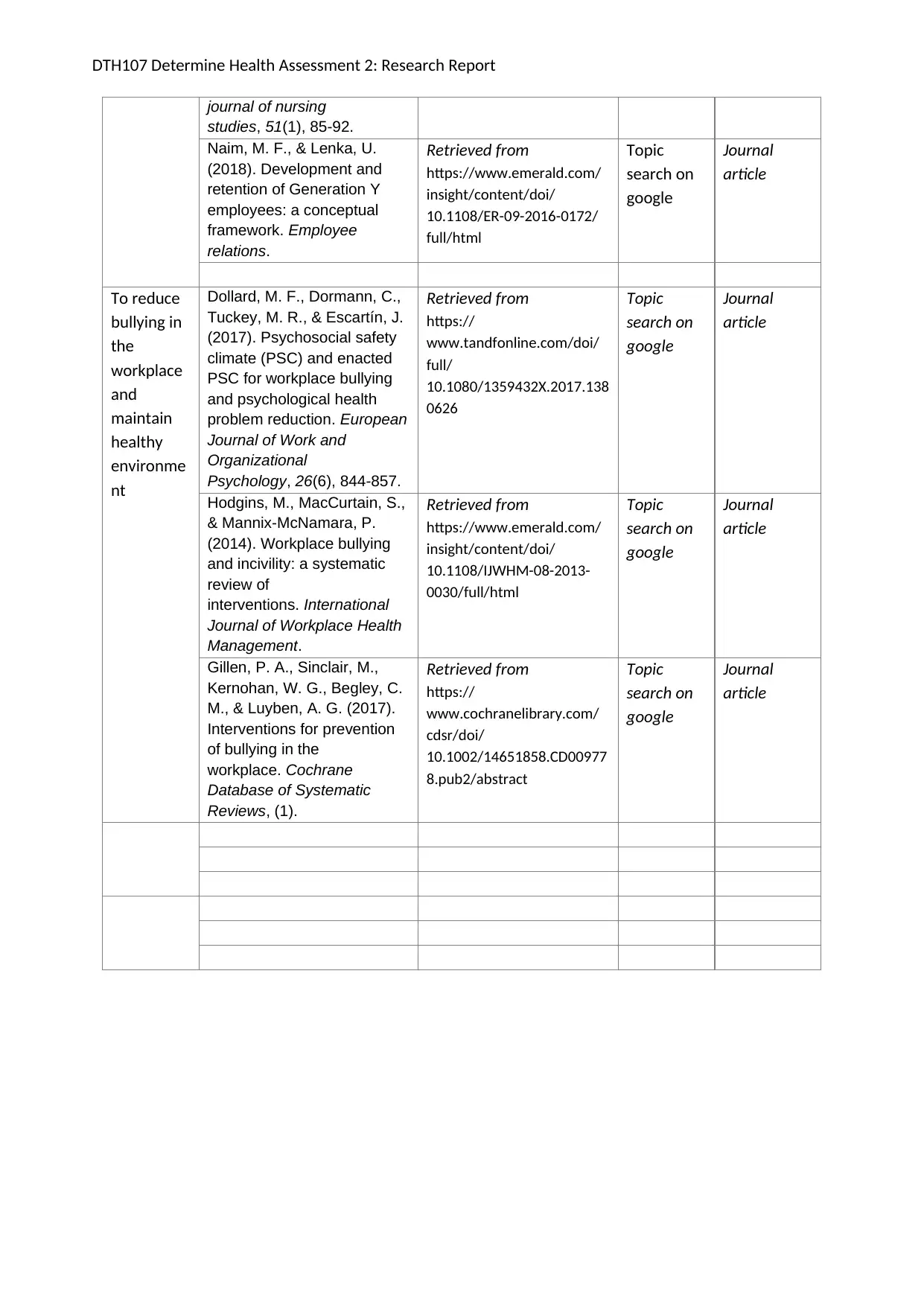
DTH107 Determine Health Assessment 2: Research Report
journal of nursing
studies, 51(1), 85-92.
Naim, M. F., & Lenka, U.
(2018). Development and
retention of Generation Y
employees: a conceptual
framework. Employee
relations.
Retrieved from
https://www.emerald.com/
insight/content/doi/
10.1108/ER-09-2016-0172/
full/html
Topic
search on
google
Journal
article
To reduce
bullying in
the
workplace
and
maintain
healthy
environme
nt
Dollard, M. F., Dormann, C.,
Tuckey, M. R., & Escartín, J.
(2017). Psychosocial safety
climate (PSC) and enacted
PSC for workplace bullying
and psychological health
problem reduction. European
Journal of Work and
Organizational
Psychology, 26(6), 844-857.
Retrieved from
https://
www.tandfonline.com/doi/
full/
10.1080/1359432X.2017.138
0626
Topic
search on
google
Journal
article
Hodgins, M., MacCurtain, S.,
& Mannix-McNamara, P.
(2014). Workplace bullying
and incivility: a systematic
review of
interventions. International
Journal of Workplace Health
Management.
Retrieved from
https://www.emerald.com/
insight/content/doi/
10.1108/IJWHM-08-2013-
0030/full/html
Topic
search on
google
Journal
article
Gillen, P. A., Sinclair, M.,
Kernohan, W. G., Begley, C.
M., & Luyben, A. G. (2017).
Interventions for prevention
of bullying in the
workplace. Cochrane
Database of Systematic
Reviews, (1).
Retrieved from
https://
www.cochranelibrary.com/
cdsr/doi/
10.1002/14651858.CD00977
8.pub2/abstract
Topic
search on
google
Journal
article
journal of nursing
studies, 51(1), 85-92.
Naim, M. F., & Lenka, U.
(2018). Development and
retention of Generation Y
employees: a conceptual
framework. Employee
relations.
Retrieved from
https://www.emerald.com/
insight/content/doi/
10.1108/ER-09-2016-0172/
full/html
Topic
search on
Journal
article
To reduce
bullying in
the
workplace
and
maintain
healthy
environme
nt
Dollard, M. F., Dormann, C.,
Tuckey, M. R., & Escartín, J.
(2017). Psychosocial safety
climate (PSC) and enacted
PSC for workplace bullying
and psychological health
problem reduction. European
Journal of Work and
Organizational
Psychology, 26(6), 844-857.
Retrieved from
https://
www.tandfonline.com/doi/
full/
10.1080/1359432X.2017.138
0626
Topic
search on
Journal
article
Hodgins, M., MacCurtain, S.,
& Mannix-McNamara, P.
(2014). Workplace bullying
and incivility: a systematic
review of
interventions. International
Journal of Workplace Health
Management.
Retrieved from
https://www.emerald.com/
insight/content/doi/
10.1108/IJWHM-08-2013-
0030/full/html
Topic
search on
Journal
article
Gillen, P. A., Sinclair, M.,
Kernohan, W. G., Begley, C.
M., & Luyben, A. G. (2017).
Interventions for prevention
of bullying in the
workplace. Cochrane
Database of Systematic
Reviews, (1).
Retrieved from
https://
www.cochranelibrary.com/
cdsr/doi/
10.1002/14651858.CD00977
8.pub2/abstract
Topic
search on
Journal
article
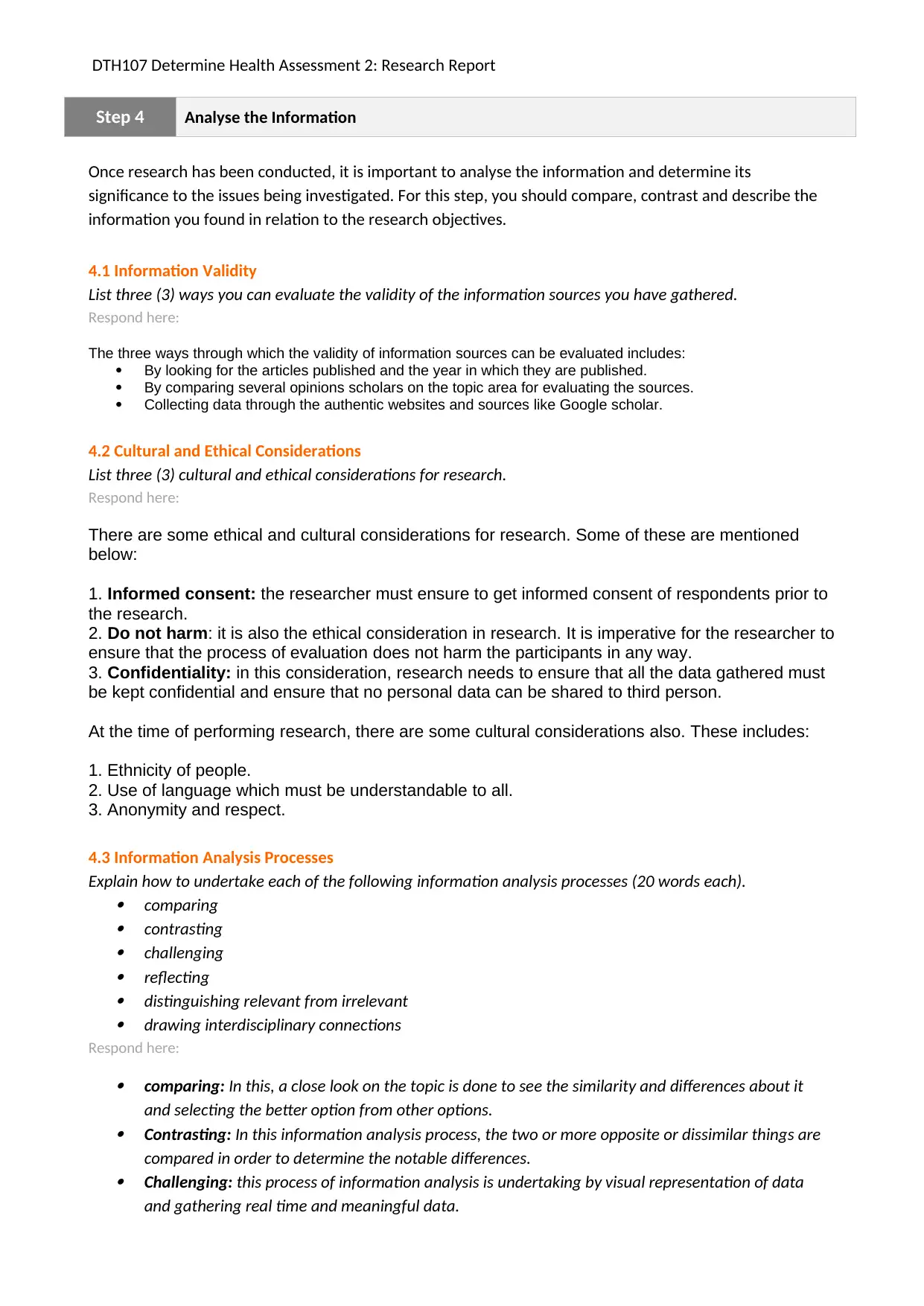
DTH107 Determine Health Assessment 2: Research Report
Step 4 Analyse the Information
Once research has been conducted, it is important to analyse the information and determine its
significance to the issues being investigated. For this step, you should compare, contrast and describe the
information you found in relation to the research objectives.
4.1 Information Validity
List three (3) ways you can evaluate the validity of the information sources you have gathered.
Respond here:
The three ways through which the validity of information sources can be evaluated includes:
By looking for the articles published and the year in which they are published.
By comparing several opinions scholars on the topic area for evaluating the sources.
Collecting data through the authentic websites and sources like Google scholar.
4.2 Cultural and Ethical Considerations
List three (3) cultural and ethical considerations for research.
Respond here:
There are some ethical and cultural considerations for research. Some of these are mentioned
below:
1. Informed consent: the researcher must ensure to get informed consent of respondents prior to
the research.
2. Do not harm: it is also the ethical consideration in research. It is imperative for the researcher to
ensure that the process of evaluation does not harm the participants in any way.
3. Confidentiality: in this consideration, research needs to ensure that all the data gathered must
be kept confidential and ensure that no personal data can be shared to third person.
At the time of performing research, there are some cultural considerations also. These includes:
1. Ethnicity of people.
2. Use of language which must be understandable to all.
3. Anonymity and respect.
4.3 Information Analysis Processes
Explain how to undertake each of the following information analysis processes (20 words each). comparing contrasting challenging reflecting distinguishing relevant from irrelevant drawing interdisciplinary connections
Respond here: comparing: In this, a close look on the topic is done to see the similarity and differences about it
and selecting the better option from other options. Contrasting: In this information analysis process, the two or more opposite or dissimilar things are
compared in order to determine the notable differences. Challenging: this process of information analysis is undertaking by visual representation of data
and gathering real time and meaningful data.
Step 4 Analyse the Information
Once research has been conducted, it is important to analyse the information and determine its
significance to the issues being investigated. For this step, you should compare, contrast and describe the
information you found in relation to the research objectives.
4.1 Information Validity
List three (3) ways you can evaluate the validity of the information sources you have gathered.
Respond here:
The three ways through which the validity of information sources can be evaluated includes:
By looking for the articles published and the year in which they are published.
By comparing several opinions scholars on the topic area for evaluating the sources.
Collecting data through the authentic websites and sources like Google scholar.
4.2 Cultural and Ethical Considerations
List three (3) cultural and ethical considerations for research.
Respond here:
There are some ethical and cultural considerations for research. Some of these are mentioned
below:
1. Informed consent: the researcher must ensure to get informed consent of respondents prior to
the research.
2. Do not harm: it is also the ethical consideration in research. It is imperative for the researcher to
ensure that the process of evaluation does not harm the participants in any way.
3. Confidentiality: in this consideration, research needs to ensure that all the data gathered must
be kept confidential and ensure that no personal data can be shared to third person.
At the time of performing research, there are some cultural considerations also. These includes:
1. Ethnicity of people.
2. Use of language which must be understandable to all.
3. Anonymity and respect.
4.3 Information Analysis Processes
Explain how to undertake each of the following information analysis processes (20 words each). comparing contrasting challenging reflecting distinguishing relevant from irrelevant drawing interdisciplinary connections
Respond here: comparing: In this, a close look on the topic is done to see the similarity and differences about it
and selecting the better option from other options. Contrasting: In this information analysis process, the two or more opposite or dissimilar things are
compared in order to determine the notable differences. Challenging: this process of information analysis is undertaking by visual representation of data
and gathering real time and meaningful data.
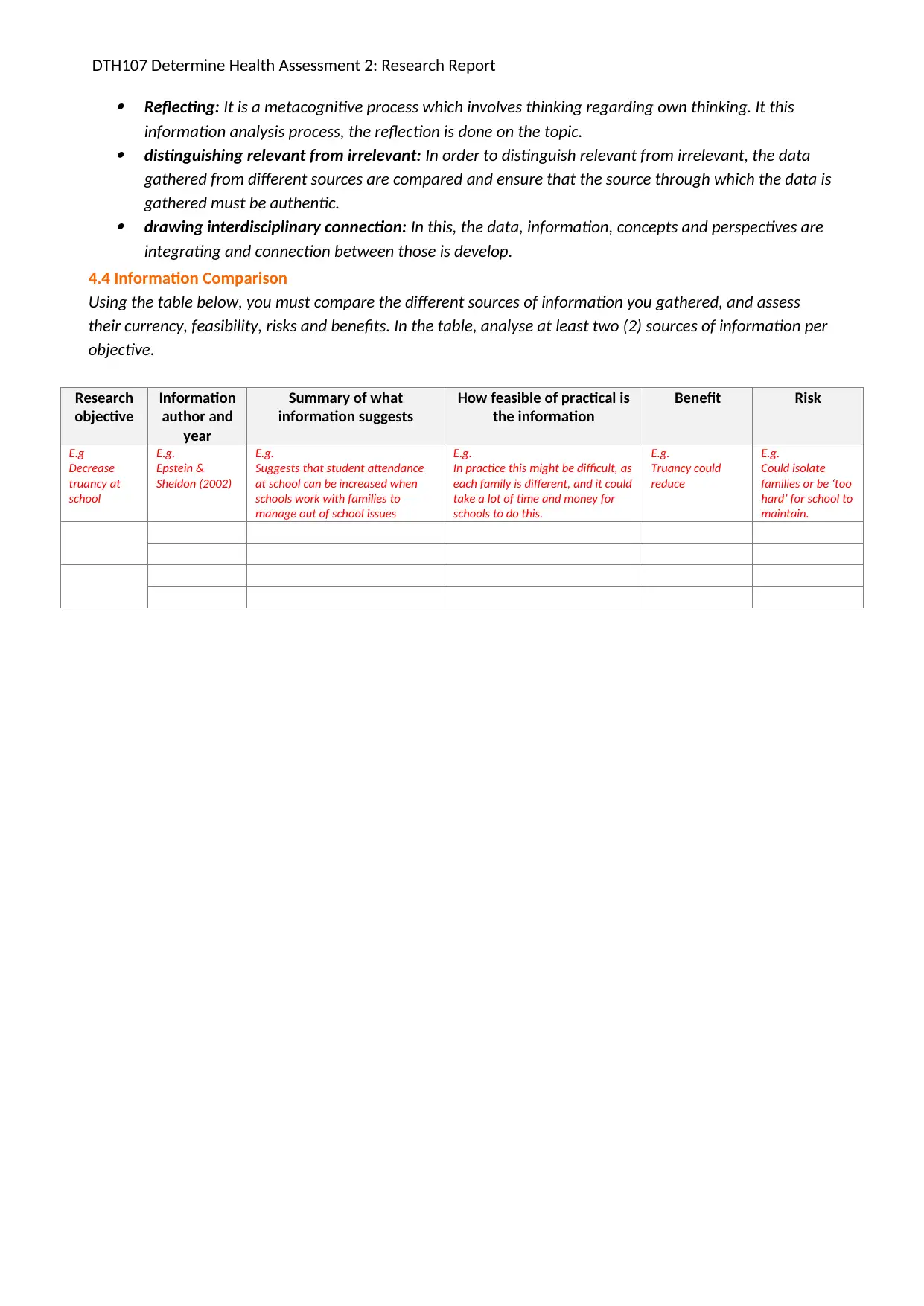
DTH107 Determine Health Assessment 2: Research Report
Reflecting: It is a metacognitive process which involves thinking regarding own thinking. It this
information analysis process, the reflection is done on the topic. distinguishing relevant from irrelevant: In order to distinguish relevant from irrelevant, the data
gathered from different sources are compared and ensure that the source through which the data is
gathered must be authentic. drawing interdisciplinary connection: In this, the data, information, concepts and perspectives are
integrating and connection between those is develop.
4.4 Information Comparison
Using the table below, you must compare the different sources of information you gathered, and assess
their currency, feasibility, risks and benefits. In the table, analyse at least two (2) sources of information per
objective.
Research
objective
Information
author and
year
Summary of what
information suggests
How feasible of practical is
the information
Benefit Risk
E.g
Decrease
truancy at
school
E.g.
Epstein &
Sheldon (2002)
E.g.
Suggests that student attendance
at school can be increased when
schools work with families to
manage out of school issues
E.g.
In practice this might be difficult, as
each family is different, and it could
take a lot of time and money for
schools to do this.
E.g.
Truancy could
reduce
E.g.
Could isolate
families or be ‘too
hard’ for school to
maintain.
Reflecting: It is a metacognitive process which involves thinking regarding own thinking. It this
information analysis process, the reflection is done on the topic. distinguishing relevant from irrelevant: In order to distinguish relevant from irrelevant, the data
gathered from different sources are compared and ensure that the source through which the data is
gathered must be authentic. drawing interdisciplinary connection: In this, the data, information, concepts and perspectives are
integrating and connection between those is develop.
4.4 Information Comparison
Using the table below, you must compare the different sources of information you gathered, and assess
their currency, feasibility, risks and benefits. In the table, analyse at least two (2) sources of information per
objective.
Research
objective
Information
author and
year
Summary of what
information suggests
How feasible of practical is
the information
Benefit Risk
E.g
Decrease
truancy at
school
E.g.
Epstein &
Sheldon (2002)
E.g.
Suggests that student attendance
at school can be increased when
schools work with families to
manage out of school issues
E.g.
In practice this might be difficult, as
each family is different, and it could
take a lot of time and money for
schools to do this.
E.g.
Truancy could
reduce
E.g.
Could isolate
families or be ‘too
hard’ for school to
maintain.
Paraphrase This Document
Need a fresh take? Get an instant paraphrase of this document with our AI Paraphraser
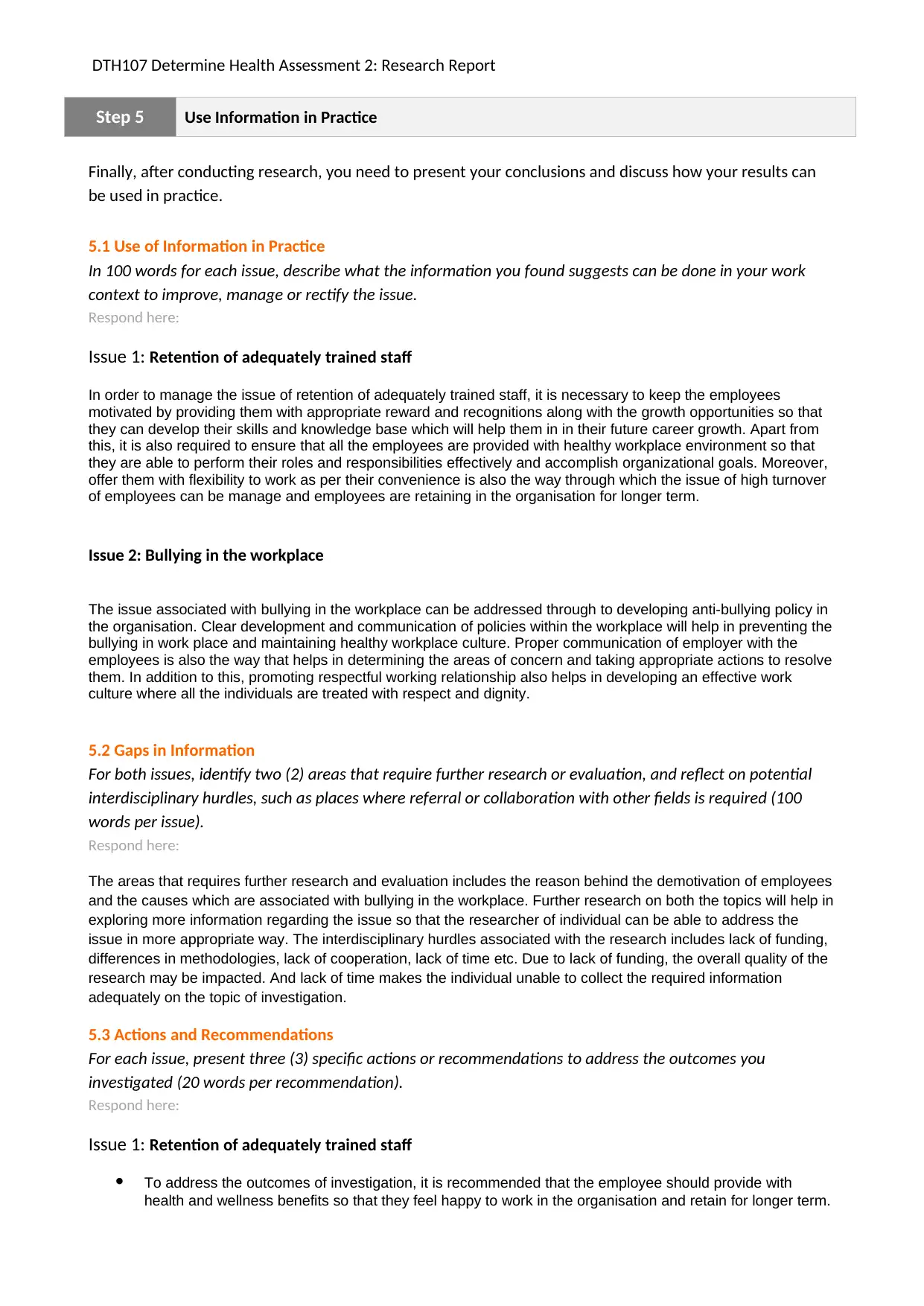
DTH107 Determine Health Assessment 2: Research Report
Step 5 Use Information in Practice
Finally, after conducting research, you need to present your conclusions and discuss how your results can
be used in practice.
5.1 Use of Information in Practice
In 100 words for each issue, describe what the information you found suggests can be done in your work
context to improve, manage or rectify the issue.
Respond here:
Issue 1: Retention of adequately trained staff
In order to manage the issue of retention of adequately trained staff, it is necessary to keep the employees
motivated by providing them with appropriate reward and recognitions along with the growth opportunities so that
they can develop their skills and knowledge base which will help them in in their future career growth. Apart from
this, it is also required to ensure that all the employees are provided with healthy workplace environment so that
they are able to perform their roles and responsibilities effectively and accomplish organizational goals. Moreover,
offer them with flexibility to work as per their convenience is also the way through which the issue of high turnover
of employees can be manage and employees are retaining in the organisation for longer term.
Issue 2: Bullying in the workplace
The issue associated with bullying in the workplace can be addressed through to developing anti-bullying policy in
the organisation. Clear development and communication of policies within the workplace will help in preventing the
bullying in work place and maintaining healthy workplace culture. Proper communication of employer with the
employees is also the way that helps in determining the areas of concern and taking appropriate actions to resolve
them. In addition to this, promoting respectful working relationship also helps in developing an effective work
culture where all the individuals are treated with respect and dignity.
5.2 Gaps in Information
For both issues, identify two (2) areas that require further research or evaluation, and reflect on potential
interdisciplinary hurdles, such as places where referral or collaboration with other fields is required (100
words per issue).
Respond here:
The areas that requires further research and evaluation includes the reason behind the demotivation of employees
and the causes which are associated with bullying in the workplace. Further research on both the topics will help in
exploring more information regarding the issue so that the researcher of individual can be able to address the
issue in more appropriate way. The interdisciplinary hurdles associated with the research includes lack of funding,
differences in methodologies, lack of cooperation, lack of time etc. Due to lack of funding, the overall quality of the
research may be impacted. And lack of time makes the individual unable to collect the required information
adequately on the topic of investigation.
5.3 Actions and Recommendations
For each issue, present three (3) specific actions or recommendations to address the outcomes you
investigated (20 words per recommendation).
Respond here:
Issue 1: Retention of adequately trained staff
To address the outcomes of investigation, it is recommended that the employee should provide with
health and wellness benefits so that they feel happy to work in the organisation and retain for longer term.
Step 5 Use Information in Practice
Finally, after conducting research, you need to present your conclusions and discuss how your results can
be used in practice.
5.1 Use of Information in Practice
In 100 words for each issue, describe what the information you found suggests can be done in your work
context to improve, manage or rectify the issue.
Respond here:
Issue 1: Retention of adequately trained staff
In order to manage the issue of retention of adequately trained staff, it is necessary to keep the employees
motivated by providing them with appropriate reward and recognitions along with the growth opportunities so that
they can develop their skills and knowledge base which will help them in in their future career growth. Apart from
this, it is also required to ensure that all the employees are provided with healthy workplace environment so that
they are able to perform their roles and responsibilities effectively and accomplish organizational goals. Moreover,
offer them with flexibility to work as per their convenience is also the way through which the issue of high turnover
of employees can be manage and employees are retaining in the organisation for longer term.
Issue 2: Bullying in the workplace
The issue associated with bullying in the workplace can be addressed through to developing anti-bullying policy in
the organisation. Clear development and communication of policies within the workplace will help in preventing the
bullying in work place and maintaining healthy workplace culture. Proper communication of employer with the
employees is also the way that helps in determining the areas of concern and taking appropriate actions to resolve
them. In addition to this, promoting respectful working relationship also helps in developing an effective work
culture where all the individuals are treated with respect and dignity.
5.2 Gaps in Information
For both issues, identify two (2) areas that require further research or evaluation, and reflect on potential
interdisciplinary hurdles, such as places where referral or collaboration with other fields is required (100
words per issue).
Respond here:
The areas that requires further research and evaluation includes the reason behind the demotivation of employees
and the causes which are associated with bullying in the workplace. Further research on both the topics will help in
exploring more information regarding the issue so that the researcher of individual can be able to address the
issue in more appropriate way. The interdisciplinary hurdles associated with the research includes lack of funding,
differences in methodologies, lack of cooperation, lack of time etc. Due to lack of funding, the overall quality of the
research may be impacted. And lack of time makes the individual unable to collect the required information
adequately on the topic of investigation.
5.3 Actions and Recommendations
For each issue, present three (3) specific actions or recommendations to address the outcomes you
investigated (20 words per recommendation).
Respond here:
Issue 1: Retention of adequately trained staff
To address the outcomes of investigation, it is recommended that the employee should provide with
health and wellness benefits so that they feel happy to work in the organisation and retain for longer term.
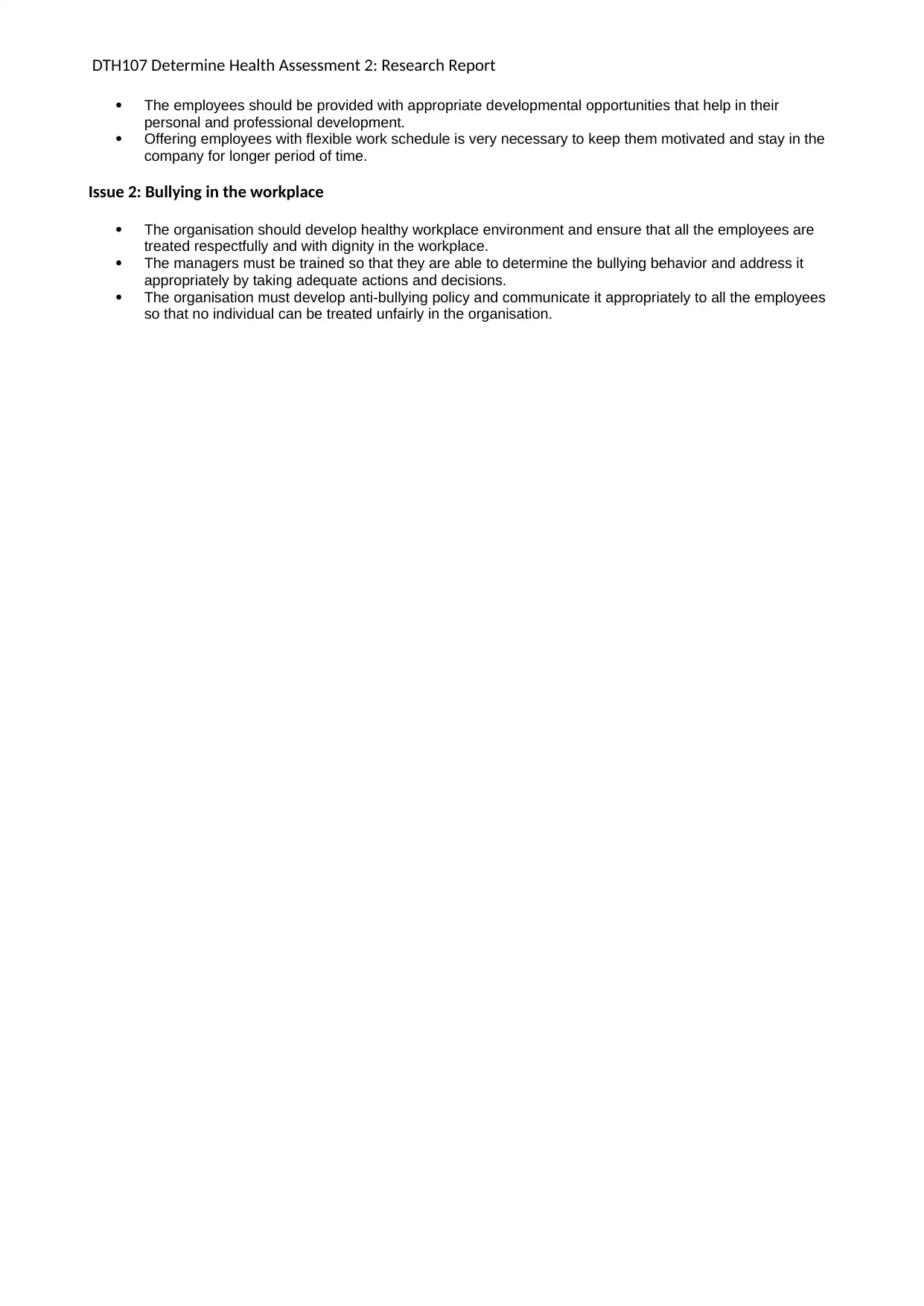
DTH107 Determine Health Assessment 2: Research Report
The employees should be provided with appropriate developmental opportunities that help in their
personal and professional development.
Offering employees with flexible work schedule is very necessary to keep them motivated and stay in the
company for longer period of time.
Issue 2: Bullying in the workplace
The organisation should develop healthy workplace environment and ensure that all the employees are
treated respectfully and with dignity in the workplace.
The managers must be trained so that they are able to determine the bullying behavior and address it
appropriately by taking adequate actions and decisions.
The organisation must develop anti-bullying policy and communicate it appropriately to all the employees
so that no individual can be treated unfairly in the organisation.
The employees should be provided with appropriate developmental opportunities that help in their
personal and professional development.
Offering employees with flexible work schedule is very necessary to keep them motivated and stay in the
company for longer period of time.
Issue 2: Bullying in the workplace
The organisation should develop healthy workplace environment and ensure that all the employees are
treated respectfully and with dignity in the workplace.
The managers must be trained so that they are able to determine the bullying behavior and address it
appropriately by taking adequate actions and decisions.
The organisation must develop anti-bullying policy and communicate it appropriately to all the employees
so that no individual can be treated unfairly in the organisation.
1 out of 15
Related Documents
Your All-in-One AI-Powered Toolkit for Academic Success.
+13062052269
info@desklib.com
Available 24*7 on WhatsApp / Email
![[object Object]](/_next/static/media/star-bottom.7253800d.svg)
Unlock your academic potential
© 2024 | Zucol Services PVT LTD | All rights reserved.





